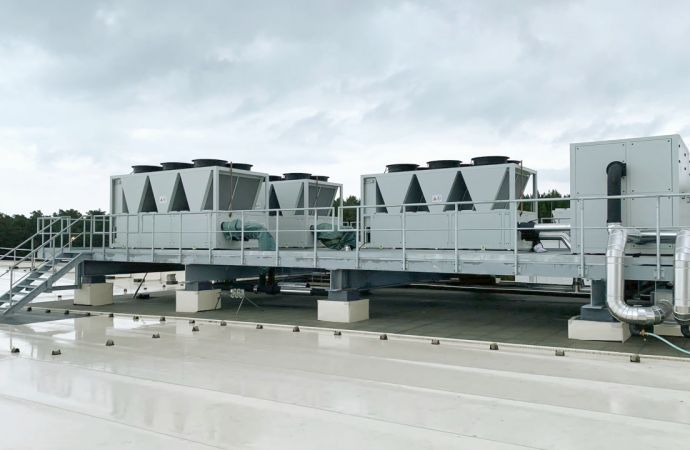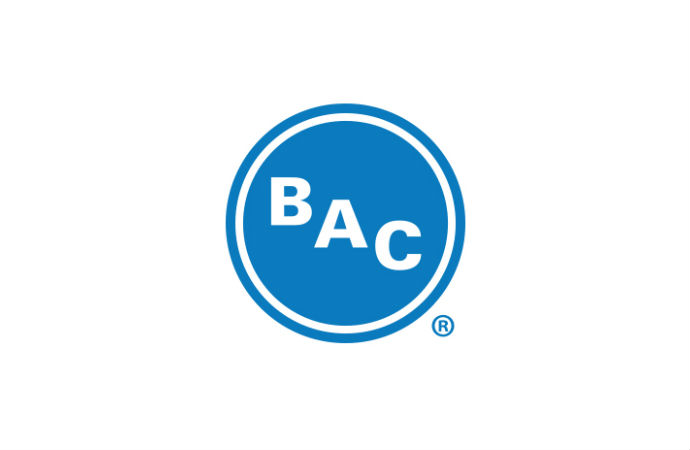BAC says its new unit is up to 60% more energy efficient than air-cooled units, uses up to 70% less water than traditional evaporative fluid coolers.

Baltimore Aircoil Company's HXV Hybrid Cooler
Baltimore Aircoil Company (BAC), a U.S. manufacturer of CO2 evaporative and adiabatic cooling equipment, has launched a new hybrid cooling technology, which it says reduces energy and water consumption.
BAC’s new heat transfer technology is a response to the demand for more water-efficient technology, especially in applications and areas where water is scarce, or expensive.
A model utilizing the new technology is named the HXV Hybrid Cooler. The HXV has a crossflow design, a higher dry switch point, and multiple operating modes, including the option for dry operation. It has a total fan capacity of 40HP. Target areas include data centers, manufacturing, process cooling and HVAC operations.
BAC’s Trillium adiabatic gas cooler is widely used with transcritical CO2 systems installed at supermarkets throughout the U.S.
One of the first to adopt the HXV Hybrid Cooler was a large liquefied natural gas facility, which installed the unit for its process cooling loop. The main factors for the customer choosing this solution were water savings and plume abatement.
Additionally, the facility valued the modular nature of the HXV, which allows for “minimized site labor and faster install time compared to field-erected equipment,” BAC said. “This ultimately results in lower contractor risk and on-time completion.”
The HXV model boasts up to 70% water savings, and up to 25% savings on maintenance, compared to traditional evaporative fluid coolers, according to Ben Cohen, BAC’s Manager of Product Marketing for North America. A key part of the general maintenance cost savings is the 70% chemical savings, since the equipment can operate dry throughout much of the year.
The HXV is also up to 60% more energy-efficient than air-cooled units, Cohen said.
The dry switch point for the crossflow hybrid technology is 32.4°F (0.22°C), 11.4 °F (6.3°C) higher than a traditional model, said BAC; the higher dry switch point minimizes both water and chemical use.
The reduced maintenance costs are a result of the design. “The crossflow design provides easy and fast access with ample room to access key components – especially the coil, motors, fill and spray branches, and water collection basin,” Cohen explained.
The HXV’s design includes two coil sections, a prime surface coil section and a finned coil section. The sections can operate in three different modes – combined wet/dry (energy saver), adiabatic and dry (water saver). “This means that users can balance water and energy savings based on their specific application needs,” Cohen explained, adding that the energy saver mode offers the most efficient heat transfer and flow control.
Energy saver mode
In energy saver mode, initial cooling in the HXV occurs in the finned coil section, as air passing over the coils pre-cools the internal fluid. Spray water is then distributed over the prime surface coil section and the primary evaporative cooling occurs.
Using both “sensible” and evaporative heat transfer, the energy saver mode results in “significant water savings compared to conventional evaporative units, even at peak design conditions,” Cohen said. Sensible cooling as the process where “only the sensible heat of the air is removed so as to reduce its temperature, and there is no change in the air’s moisture content,” he explained.
Adiabatic and water saver modes
In adiabatic operations, the process fluid flows only through the finned coil section, bypassing the prime surface coil section. Water continues to evaporate, precooling the incoming air before it reaches the finned coil. This “greatly” increases the rate of sensible heat transfer.
Adiabatic mode reduces water consumption up to 75%, while “maintaining the low fluid design temperatures required to maximize system efficiency,” Cohen said. An additional benefit to adiabatic mode, important to some operators, is that it reduces the visible plume often happening in cold and damp conditions when the air is fully saturated.
In water-saver mode both coil areas are in use, to maximize the heat transfer area, but the water spray pump is turned off, meaning there is zero water consumption. Water saving mode eliminates the plume entirely, and units can “can achieve even higher dry switch points when running at partial load,” Cohen said.
Users can balance water and energy savings based on their specific application needs," - Ben Cohen, BAC
Related stories


_1635407946.jpg)

